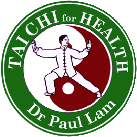

Crystal T’ai Chi © - All Rights Reserved. Page updated 15 January 2015


This Site is regularly updated. If you spot any problems or missing links please let us know.



Exercise is an essential part of many approaches to controlling conditions like Multiple
Sclerosis .T’ai Chi is therefore a valuable aid for those with MS. Dr Paul Lam’s T’ai Chi for Arthritis program, seated or standing, together with Qi Gong has proven success as a gentle exercise routine for those with MS.
View our article “How T’ai Chi helps with MS”
T’ai Chi exercises are easily adapted for sitting, standing or walking, to increase body awareness by controlling balance, keeping the body aligned, and when moving backwards, forwards, or sideways, how to touch down first. Moving with the mindful intention to control, Tai Chi exercises provide practice to consciously transfer the body weight forward and back without loss of body alignment.


Dr Paul Lam has produced a modified short form specifically to aid and help prevent the onset of Diabetes. This form is based on movements of Sun and Yang style.
Trevor is a trained instructor for this form.

Supported by Diabetes Australia, the form is designed to help prevent and improve the control of diabetes by providing the progressive exercises that are desirable for people with this illness. The gently increasing physical activities stimulate cellular uptake of glucose and relaxation and generally improves the cardio-vascular system. This enhances Qi (life energy), which according to traditional Chinese medicine will help control diabetes.
This program can also be used for general fitness and health. It is suitable for people with no prior knowledge of Tai Chi, and is safe and easy to learn.
Dr Paul has worked with the University of New South Wales on a study to show how Tai Chi for Diabetes improves glucose control. This study was published by Australian Family Physician's Journal October 2008.
Click here to see the story on the University of NSW YouTube postings.

| Sifu Trevor |
| Assistants |
| Find a Session |
| Workshops |
| Events |
| Tai Chi for Energy |
| Talks |
| 1to1 Tuition |
| Our Classes |
| Training Us |
| Events & Workshops |
| Sword & Fan |
| Kidz |
| My Favourite Place |
| Info & Articles |
| Videos |
| Useful related websites |
| Testimonials |
| A T'ai Chi Poem |